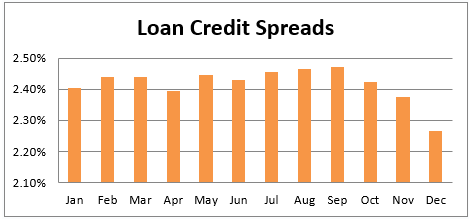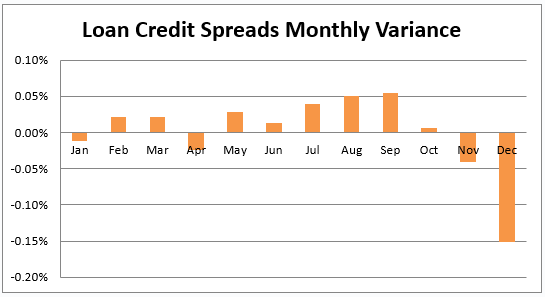Is There Seasonality in Loan Credit Spreads?
Research demonstrates that many companies do not sell their products or services evenly throughout the week, month, quarter, or year. Instead, in many industries, revenue and profit margins can fluctuate substantially throughout periods. It pays for community banks to not pay attention to this phenomenon in order to increase margins, but due to the vaccine, credit spreads are likely to decrease during the back half of the year as banks increase credit supply. Finally, while obvious, it is worth noting that a loan booked in January is worth 12x more than a loan booked in December when it comes to meeting revenue goals.
Why Sales Fluctuate
Sales may fluctuate for a number of reasons, including, 1) sales reps are motivated by budget goals which must be achieved at the end of the month, quarter, or year; 2) clients are conditioned to expect a change in behavior from sales reps and come to expect discounts at the end of periods; and, 3) different times in a period elicits different demands by end-users. Research carried out by InsideSales.com looked at 9.8 million transactions over nine quarter-year periods from reps at 151 companies. They found that “artificial haste,” driven by end-of-period pressure, is a major contributor to higher sales and a higher percentage of lost sales. In other words, while salespeople sell more at period-end, they also have a lower success rate and obtain lower profit margins. Had reps been more patient with the sales process, the prospect would be converted but at a slower pace, but with a higher profit margin.
Banking is also a sales-driven business, and banks typically set production budgets for the calendar year, and many lenders are given individual quotas, or incentive pay, for loan generation. We looked at almost a thousand loans originated over more than three years by approximately 50 community banks across the country, and we measured if seasonality affects loan pricing. The yield on the loans was compared based on the month of production.
Results
The average loan size in our sample was just over $2mm. Each loan was a “bankable” credit, and all loans were pass-rated credits. We excluded loans that originated in 2020 because of the Covid-19 impact. Almost all loans had DSC ratios above 1.2X, and almost all loans had LTVs below 85% (with a majority below 75%). The average loan credit spread over FTP (in this case, we used LIBOR) was 2.41%. The highest monthly loan credit spread was 2.47% and occurred in the months of August and September. By far, the lowest spread (2.26%) was in December. The graph below shows the average monthly spreads for all loans categorized by the month of loan closing.

The graph below shows the monthly variance to the yearly average. It shows that the lowest loan credit spreads were booked on loans that closed in December, and the second-lowest spreads were booked on loans that closed in November. The months of January and April were also below average. While September, August, and July were the highest credit spreads for community banks.

The above data does make intuitive sense. The loan closing cycle takes somewhere, on average, between four and eight weeks. Loans booked in December are quoted and underwritten in October or November. It appears that seasonality driven by year-end budgets is a very powerful force in banking. Lenders (and bank management), motivated to meet budget numbers, are driving down interest margin in the last three months of the year. Loans closings in October, November, and December have lower spreads than loans closing throughout the rest of the year. Some of that net interest margin (NIM) compression spills over into January, where bankers are closing loans that were quoted in November and December of the previous year.
Recommendations
Seasonality has a powerful effect on commercial loan margins. Bankers that understand this phenomenon can take advantage of the market by setting loan production budgets for the period ending in September rather than December. In 2021, banks should especially emphasize loan production early in the year since the next few months will allow banks to price a pandemic premium on loans (anywhere from 25 to 50 bps in additional credit spread), and we believe that this premium will disappear in the market by the end of Q2/21 as the pandemic ebbs. Banks that book these loans early can enjoy a longer run of interest earnings in 2021 than if they book them late.
To take advantage of these trends, banks should shift the bulk of their commercial marketing dollars into the first quarter and support that by the most aggressive sales calling program of the year. For banks that want to grow their conventional loan book in 2021, the best months for profitability will be between January and March of this year. Loan sales are not a passive exercise, to drive more production, come out of the gates early and stay focused on those quality borrowers that look to increase capital. Rising rates, more stimulus and banks increasing their post-pandemic lending effort to make up for lost time are all reasons to help your borrowers now.

